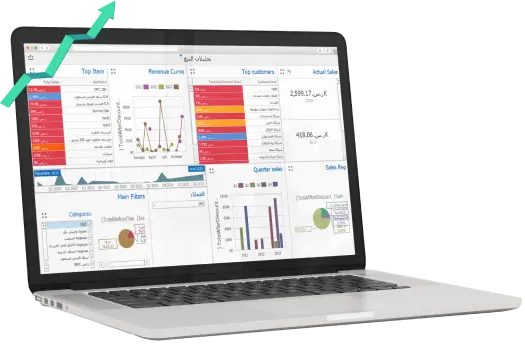Presentation of Financial Statements means how to present, organize, classify, and group items in the financial statements, as well as the notes to the financial statements, and the financial statements are
- A statement of financial position (balance sheet) at the end of the period.
- A statement of profit or loss (income statement).
- Other comprehensive income for the period.
- A statement of changes in equity.
- A statement of cash flows.
- Notes, comprising a summary of significant accounting policies and other explanatory notes and comparative information prescribed by the standard.
General Features
1- Fair Presentation: The financial statements must "present fairly" the financial position, financial performance and cash flows of an entity. Fair presentation requires the faithful representation of the effects of transactions, other events, and conditions in accordance with the definitions and recognition criteria for assets, liabilities, income and expenses set out in the Framework. The application of IFRSs, with additional disclosure when necessary, is presumed to result in financial statements that achieve a fair presentation.
The information contained in financial statements should have all the qualitative characteristics of financial statements, complete disclosure should be given as per the IFRS. The entity will be treated as going concern.
2- Going Concern: The Conceptual Framework notes that financial statements are normally prepared assuming the entity is a going concern and will continue in operation for the foreseeable future.
3- Consistency of Presentation: The presentation and classification of items in the financial statements shall be retained from one period to the next unless a change is justified either by a change in circumstances or a requirement of a new IFRS.
Assets and liabilities, and income and expenses, may not be offset unless required or permitted by an IFRS.
4- Comparative Information: IAS 1 requires that comparative information to be disclosed in respect of the previous period for all amounts reported in the financial statements.
5- Frequency of Reporting: An entity shall present a complete set of financial statements at least annually. When an entity changes the end of its reporting period and presents financial statements for a period longer or shorter than one year an entity shall disclose, in addition to the period covered by the financial statements and the reason for using a longer or shorter period.
Identification of Financial Statements
- The title of the entity presenting financial statements.
- Whether these are the financial statements of an individual entity or consolidated financial statements for the group of entities.
- The reporting date for which financial statements are presented.
- The presentation currency for the amounts reported in financial statements.
- The level of rounding up for the amounts reported in financial statements (e.g. thousands, millions).
Statement of Financial Position (Balance Sheet)
An entity must normally present a classified statement of financial position, separating current and non-current assets and liabilities. In either case, if an asset (liability) category combines amounts that will be received (settled) after 12 months with assets (liabilities) that will be received (settled) within 12 months, note disclosure is required that separates the longer-term amounts from the 12-month amounts.
Non-deferred tax liabilities and non-deferred tax assets not classified as current assets or current liabilities
Some current liabilities, such as trade payables and some accruals for employee and other operating costs, are part of the working capital used in the entity’s normal operating cycle. An entity classifies such operating items as current liabilities even if they are due to be settled more than twelve months after the reporting period.
The entity will present an asset as a current asset if it meets any of the following criteria:
- Expected to be realized in the entity's normal operating cycle
- Held primarily for the purpose of trading
- Expected to be realized within 12 months after the reporting period
- It is cash and cash equivalents (unless restricted)
All other assets are non-current.
Current assets such as customers and inventory are usually sold, used, or realized within 12 months after the reporting period
Even if it is not expected to realize within 12 months after the reporting period, it is also considered as a current asset
Current assets also include assets for which the held primarily for the purpose of trading and speculation, such as investments for the purpose of trading.
This Standard uses the term "non-current" to include tangible, intangible, operating and financial assets of a long-term nature. It does not prohibit the use of alternative descriptions as long as the meaning is clear.
Current liabilities are those:
- Expected to be settled within the entity's normal operating cycle
- Held for purpose of trading
- Due to be settled within 12 months
- For which the entity does not have the right at the end of the reporting period to defer settlement beyond 12 months.
Other liabilities are non-current.
Some current liabilities, such as trade payables and some accruals for employee and other operating costs, are part of the working capital used in the entity’s normal operating cycle. An entity classifies such operating items as current liabilities even if they are due to be settled more than twelve months after the reporting period.
Other current liabilities:
Bank overdrafts - short-term loan
The current portion of non-current financial liabilities
Dividends payable
Trade and Other Payables
Provisions
Income taxes
Due to related parties
Long-Term Liabilities:
Long-Term Loans
Deferred tax liabilities
Long-Term Notes Payable
If a liability has become payable on demand because an entity has breached an undertaking under a long-term loan agreement on or before the reporting date, the liability is current, even if the lender has agreed, after the reporting date and before the authorization of the financial statements for issue, not to demand payment as a consequence of the breach. However, the liability is classified as non-current if the lender agreed by the reporting date to provide a period of grace ending at least 12 months after the end of the reporting period, within which the entity can rectify the breach and during which the lender cannot demand immediate repayment.
Fixed assets and intangible assets are classified under non-current assets and they appear in the statement of financial position by net (cost - accumulated depreciation or amortization)
In the event that fixed assets are transferred to non-current assets held for sale, they are disclosed in the notes
Profit or Loss Statement
The following minimum information must be presented in the statement of profit or loss:
1- Revenue;
2- Post-tax profit;
3- Tax expense;
4- Share of the profit or loss of associates and joint ventures accounted for using the equity method;
5- Finance costs;
6- Profit or loss.
There are other line items in some companies such as gains and losses from the derecognition of financial assets measured at amortized cost
Statement of Changes in Equity
There must be a note for each class of the share capital, meaning
Numbers of shares authorized, issued and fully-paid, and issued but not fully paid, and the par value per share, the treasury shares, including shares held by subsidiaries and associates, and also the number of the preferred stocks if any
A description of the nature and purpose of each reserve within equity
Reconciliations between the carrying amounts at the beginning and the end of the period for each component of equity
Statement of cash flows
Reconciliations of profit before tax must be presented
Presentation of the Statement of Cash Flows: cash flows from operating activities - cash flow from investing activities - cash flow from financing activities
Periodic Financial Reporting & Operating Segments
The idea of operating segments is that some companies, for example, their business be in more than one product, a giant foodstuff company; its business may be to the sale of cake, croissant, crackers, and others, therefore, revenue consists of all these activities and thus to judge the efficiency of any activity, both profit and loss, revenue and costs are divided into a set of operating segments and also possible the operating segments should be at the level of the geographical areas to accurately judge the efficiency of the entity's revenues
According to Egyptian Accounting Standard No. (41) and IAS 8 disclose information to enable users of its financial statements to evaluate the nature and financial effects of the different business activities in which it engages and the different economic environments in which it operates, and defines an operating segment as follows. An operating segment is a component of an entity that engages in business activities from which it may earn revenues and incur expenses whose operating results are reviewed regularly by the entity's chief operating decision maker to make decisions about resources to be allocated to the segment and assess its performance. IFRS 8 requires an entity to report financial and descriptive information about its reportable segments. Reportable segments are operating segments or aggregations of operating segments that meet specified criteria:
Its reported revenue, from both external customers and intersegment sales or transfers, is 10% or more of the combined revenue, internal and external, of all operating segments,
The absolute measure of its reported profit or loss is 10% or more of the greater, in absolute amount, of (i) the combined reported profit of all operating segments that did not report a loss and (ii) the combined reported loss of all operating segments that reported a loss,
Its assets are 10% or more of the combined assets of all operating segments.
Two or more operating segments may be aggregated into a single operating segment if aggregation is consistent with the core principles of the standard, the segments have similar economic characteristics and are similar in various prescribed respects:
The nature of the products and services, the nature of the production processes, the type or class of customer for their products and services, the methods used to distribute their products or provide their services. IFRS 8 states that if the total external turnover reported by the operating segments identified by the size criteria is less than 75% of total entity revenue then additional segments need to be reported on until the 75% level is reached.
The basic idea of the operating segments is that the users of the financial statements have more detailed data and information about the type of revenues and costs. The entity must disclose information about its operating segments within the notes to the financial statement so that the relationship between the entity's operations and the main components of the financial statements is noted, so that information is collected on each major product or basic geographical area and major customers and this enables shareholders and investors to make better estimates on the performance of each part of the entity also has adequate disclosure









